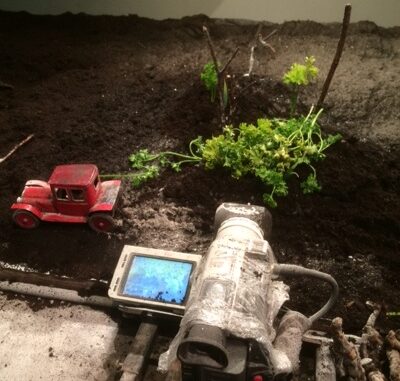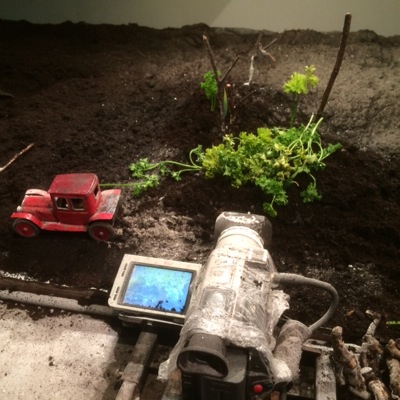
Every two years the Lift Festival brings theatre and performance to London from around the world. The 2014 edition has seen a variety of exciting new works from Belarus, Brazil and Belgium – and lots more from countries whose names don’t begin with B. Some of these are date-relevant, such as the football pieces coinciding with the World Cup (come on, England…oh…) and the WW1-based works taking their cue from 2014 being 100 years since the outbreak of the First World War.
The name of the work by Dutch team Hotel Modern and Arthur Sauer gives away which of those camps it is in. The Great War is their latest production, an ambitious title for a 70 minute show. It combines elements from film, model-making, visual art, music – and even a bit of gardening. The Great War attempts to recreate the atmosphere of the 1914-1918 war on stage, using miniature sets, toy soldiers, and cleverly realised special effects. Narration from real letters sent home from the trenches and live sound effects from composer Arthur Sauer illustrate the narrative. The result is very different to most performances you will have seen – not least in having a fire extinguisher on stage and allowing the audience to join the performers afterwards to have a poke around the equipment.

One of the cameras focused on the small models, peat and…parsley used to recreate the Western Front
To make the tiny happenings visible to the audience, cameras are focused on the small-scale activity. Their output appears on a big screen at the back of the stage, above several areas of equipment. Some of these are electrical, some look like market stalls – one of which is long and has peat spread out on it at hip height. This becomes the main set for the action to follow. Another area has a fish tank full of yellow water – to be used in a submarine scene. Another reconstructs a small smashed up house. None of the production is hidden from the audience. Instruments, laptops, wires and flashing electronics are all on the stage amongst the four performers.
Artist Herman Helle and theatre-makers Pauline Kaulker and Arlene Hoornweg race between the different set-ups, creating trenches and bomb attacks in the peat, maritime disasters in the water, tank journeys and other military events. The close-up cameras project their work on the big screen, including their fingers moulding the peat, wires pulling birds and rats. Sauer’s live sound-track – including a hand-cranked horse-simulator made of coconuts – describes what is happening, along with a narrator’s voice.
The resulting images on the screen are evocative and the manipulation of materials and models is clever. But the set up with film above and performers below is distracting. The build up of the war and the complicated who declared war on whom is told from centre stage – to watch the performers is part of the act. But later they are in the gloom, peering over their peaty market stalls, lights on, or flames flashing. It is hard to know where to focus – which could be seen as evocative of the difficulties of fighting the the world’s first global conflict.
The effects are mostly impressive. Dry ice creates mustard gas. A lit sparkler knocked against a wooden box sends down fiery explosions on the battlefield. Old broom-heads make dying hedges. The sound effects illustrate the story well, Sauer having found a sound for every moment, including growing plants.
An issue is the accented English of the narrators. It occasionally requires too great an effort to understand exactly what was said. The following line or two can be missed as you run through possibilities in your mind as to what a sentence may have meant. A reference that seemed to be to …the King’s expanding feet… was quickly explained when a model ship appeared onscreen. But I was beaten by what appeared to be talk of a wounded soldier who couldn’t be rescued because he was lying amongst toys.
Helle’s inventive models and effects are the best part of the show, but the whole performance makes us privy to the filmmaking process. We see not only the end result on the big screen, but also the careful manipulations that create the illusion. The miniaturisation allows us to see the performers as military Top Brass, controlling the lives of soldiers with little concern. They move from one battle to the next making decisions about plastic soldiers as easily as high command destroyed the lives of real men. But there is no sense of the scale of death and waste of the First World War.
This ‘live-animation’ approach to history-telling will appeal to people who would not normally find theatre or WW1 of interest. Hotel Modern must be congratulated for finding a novel approach to a currently well-covered topic. Although the method doesn’t add to an understanding of the First World War, it enlivens the production and creates a memorable general introduction to World War One.
The Great War is on until 26th June at the Queen Elizabeth Hall. More details

Leave a Reply